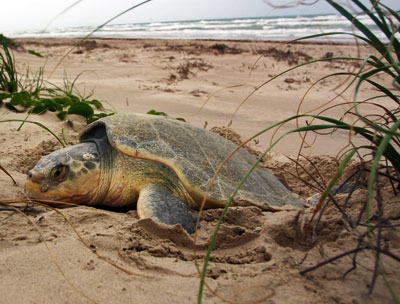Field Guide to Maryland's Turtles (Order Testudines)
Main_Content
Kemp's Ridley Sea Turtle (Lepidochelys kempii) | Common Name: Kemp’s Ridley Sea Turtle |

Photo of Kemp's Ridley Seaturtle nesting,
courtesy of National Park Service
|
Size: 23 - 27½ inches. Record - 29½ inches |
Appearance:
- Our smallest sea turtle.
- A heart-shaped carapace (top shell) which is
smooth and olive green, grey or black, with serrations along the rear
margin.
- Head and flippers are grey or olive.
- The plastron (bottom shell) is
white.
- Five costal scutes on each side of the carapace.
- The first costal scute touches the nuchal scute. Bridge scutes have pores.
|
Habitats:Marine waters of the Chesapeake Bay, coastal bays, near shore and the
continental shelf (< 150 feet deep). Often associated with eelgrass meadows.
No nesting occurs at our latitude (most nesting is at Tamaulipas, Mexico).
Most of our turtles are juveniles. During the summer months, the lower
Chesapeake Bay has the highest concentrations of juvenile Ridleys in the
world.
|
How to Find:Juveniles may be observed in the Chesapeake and coastal bays in shoal areas with eelgrass beds close to shore, feeding on blue crabs. They can also be found loafing/basking for long periods on the surface, however they maintain a low profile with the carapace mostly submerged. Look for them from May to November. |
Distribution in Maryland:This turtle is listed as Federally and State Endangered. If found, please report sightings to the Maryland Wildlife and Heritage Service. If found stranded or dead, please report sightings.
|
|
